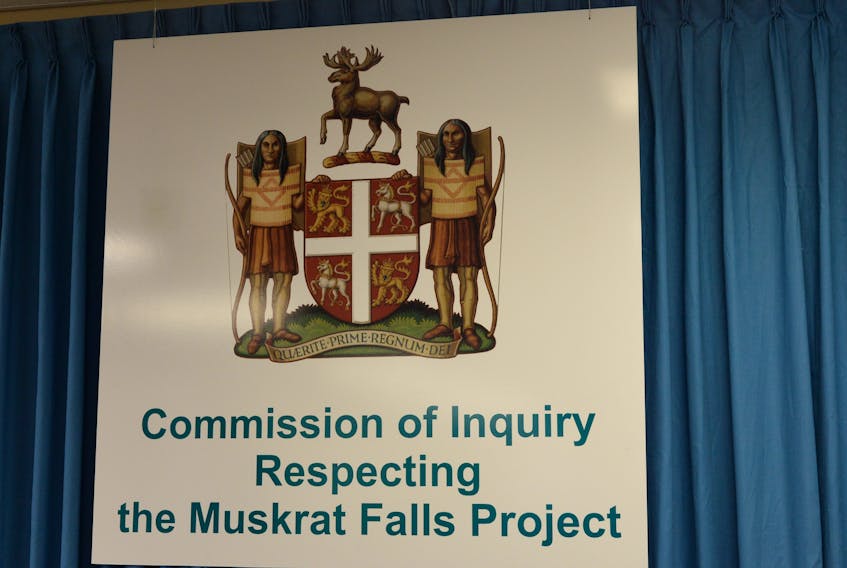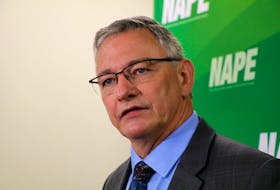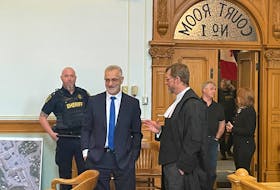HAPPY VALLEY-GOOSE BAY, N.L. — The Muskrat Falls Inquiry heard Thursday from two members of the Nunatsiavut Government who have been lead hands on addressing the issue of methylmercury and concerns over effects downstream.
Having also appeared during the first phase of the Inquiry’s work in 2018, former minister of Lands and Natural Resources for Nunatsiavut Carl McLean (now retired) and director of environment Rodd Laing gave additional testimony on events coming after the project’s sanctioning at the end of 2012. The focus was methylmercury concerns and the Make Muskrat Right campaign of the Nunatsiavut Government, beginning in late 2015.
“Part of it was a public relations exercise, but I think we saw it important to make sure the complete package of information was out there, available, explained,” McLean said of the government’s work.
“We felt we were being, not necessarily ignored, but we weren’t being taken as seriously as we thought we should have (been), with what the science was showing, by both the regulator and the proponent,” he said.
The Indigenous government felt it needed to find a way to increase public knowledge of environmental issues associated with the project, and of the science.
“I think the reality of Joint Review Panel recommendations or any scientific evidence is it needs to be put in a form that the community and generally the public can digest. That’s a huge failing of a lot of scientific research, as well as a lot of these megaprojects, is actually putting things in ways that the community can actually understand,” Laing added. “And we believe our campaign was actually very successful in doing that.”

There were many protests against the project, fuelled in part by concerns over methylmercury. But in the fall of 2016, hunger strikes and a walk onto the site (shutting down work, and so the subject of Inquiry review) preceded a “marathon meeting” of provincial government and Indigenous government leaders in St. John’s. A promise was made for the creation of an Independent Expert Advisory Committee (IEAC) to review outstanding issues.
Premier Dwight Ball has been criticized for not fulfilling promises made in relation to the IEAC.
Ball’s lawyer, Peter O’Flaherty, went back and forth with the witnesses at one point, clearly identifying exact commitments made, including the promise to establish the IEAC.
They were asked if it was true the premier never said he would automatically accept and institute the recommendations of the IEAC.
“I think that’s correct, yes,” McLean said in response.
“(But) the premier committed to responding to the recommendations … which has not happened,” Laing added.
As the Saltwire Network has reported and both McLean and Laing mentioned in their testimony, a recommendation for additional activity at the reservoir has yet to receive a direct response from the province to Nunatsiavut.
Todd Russell, president of NunatuKavut, testified on Wednesday he has also not received a direct response. The message from the premier and provincial Environment has been that it remains under review.
O’Flahery spoke about the dissenting opinion of the Innu Nation on the approach, and the additional costs involved.
McLean and Laing noted the timeline would, at this point, require a delay in first power if the proposed additional work were to be undertaken.
The testimony became caught up as the witnesses were questioned on work completed since the final report of the IEAC in April 2018. For example, a report from Dillon Consulting, dated November, specifically challenges the IEAC conclusions.
O’Flaherty asked why the witnesses wouldn’t be aware of the report, why they didn’t seek it out.
Commissioner Richard LeBlanc interjected, asking why the report wouldn’t have been provided.
A lawyer for Nalcor Energy said his understanding was the reports now in evidence were provided to Indigenous leaders and he would confirm.
But neither witness said they had been involved in discussions on the work submitted to the Crown corporation subsequent to the IEAC’s filing to the province.
Given the evidence and limited reporting to date on the more recent work, The Telegram plans to review the methylmercury issue again, including the post-IEAC reports, beginning during the break in public hearings for the Inquiry starting Monday.
The Inquiry also heard on Thursday afternoon from former Innu Nation grand chief Anastasia Qupee and Clementine Kuyper.
It will hear Friday from Pat Hussey (Nalcor Energy), before the break in public hearings. Hearings are currently scheduled to resume with a workers’ panel on March 15.
RELATED









